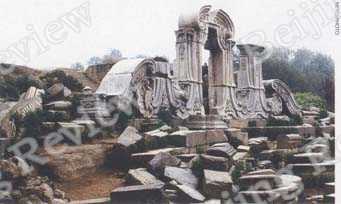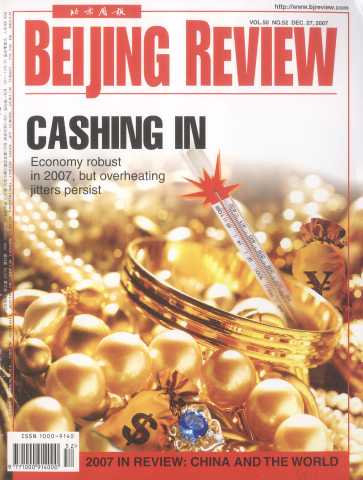Despite strong opposition, a ruined royal garden is under renovation at its original site in Beijing and at the same time the construction of an actual-size replica has begun in another city
Even for a foreigner who has lived in Beijing for years, the ruins of Yuanming Yuan might be a place they have never heard of before. But to Chinese, everyone is familiar with the ruined garden and its special meaning - not just as a scenic spot or a historical site, but as a lasting thorn in the side of national pride.
Yuanming Yuan, located just northwest of Beijing, is also known as the Old Summer Palace. Less well known to foreigners as the Summer Palace to the west of it, the 300-year-old palace that once sat on the site was the most beautiful and grandest imperial garden during the Qing Dynasty (1644-1911).
The gardens and buildings on the site once were an exquisite blend of classical Chinese architecture styles and Baroque architecture from the West. It was also home to art treasures and cultural relics and a library of valuable books.
That grandness and splendor all disappeared in 1860 when British and French troops sacked Beijing. The invaders set fire on all the royal gardens located in the western part of the city, including Yuanming Yuan, destroying most of the garden and plundering numerous treasures stored there. The vandalism of the site happened again in 1900, when allied forces of eight foreign countries (Britain, the United States, the Austro-Hungarian Empire, Italy, Russia, France, Germany and lapan) entered Beijing.
For over a century, sections of broken stone pillars have stood silently as reminders of that sad past. But in recent years, heated debate about whether the site should be reconstructed has broken the former tranquility of the garden and brought Yuanming Yuan back to national attention.
In 1999, some Chinese architectural experts proposed renovations of Yuanming Yuan. Although the proposal had few supporters at that time, moves to reconstruct the site have not stopped ever since.
At an international seminar held on October 18, 2007, to celebrate the 300th anniversary of the completion of Yuanming Yuan, Wang Zhili, founder and Vice Chairman of the Yuanming Yuan Research Society of China, appealed for efforts to restore the original landscape and garden arrangement and rebuild many of the old buildings according to the original size and style.
Like Wang, supporters for the renovation project hoped to make the rebuilt garden into a special commemorative place to showcase the history of Yuanming Yuan and the Qing Dynasty, as well as to exhibit the traditional Chinese garden design arts.

THE LEFT: One part of the ruins of Yuanming Yuan
But opponents have attached more importance to the "reminding role" of the ruins. They think that the destruction that has been left in the garden carries a heavy reminder and sadness. The pillaging of Yuanming Yuan deeply hurt the Chinese people, not only the Qing court.
No matter how heated the debate has become in the academic circles and among the general public, in 2000, the Central Government approved the renovation plan for Yuanming Yuan. Renovations have recently begun, but details about what this entails have not been released.
Compared with the recent low-key and prudent moves to begin restoration at the actual site, a private reconstruction project has garnered the latest media exposure and criticism.
The advocate of the private project, the Hengdian Sannong Promotion Society, has recently said that they have raised 1.16 billion yuan (around $155 million), and that the reconstruction will be launched in early 2008.
Xu Wenrong, President of the Hengdian Sannong Promotion Society, said that funds were acquired without large-scale fundraising. According to Xu, the money Sannong has raised is composed of three parts: 120 million yuan (some $16 million) is from a special fund management committee for the reconstruction of Yuanming Yuan, 1 billion yuan (some $133 million) is in capital that the initiator has put forward, and the remaining amounts are from private enterprises.
The entire reconstruction project, which will be located in Hengdian, in east China's Zhejiang Province - a Hollywood-like film-shooting base in the country - is planned to have a budget of 20 billion yuan ($2.7 billion) and will cover an area of 6,165 mu (around 411 hectares). It will be built with a scale of 1:1 according to the actual size of the former Yuanming Yuan outside of Beijing.
Xu said that of the 20 billion yuan, 7 billion yuan ($933 million) will be used in the construction itself. The remaining investment will be used for collecting cultural relics and manufacturing some relic imitations.
The whole construction is said to be finished in five years and is planned to be open to the public in 2013. Xu said the current 1.16 billion yuan is enough for the construction in the first year and he has confidence the additional funds won't be difficult to come by.
"We have seen high enthusiasm from various social groups both at home and abroad for the reconstruction of Yuanming Yuan in Hengdian," Xu said. Xu also said that they will hold a press -conference in April 2008 to start the first round of domestic public fundraising.
Xu, 73, who has dedicated more than a decade to researching the history and architectural and cultural value of Yuanming Yuan, said that it is his dream to rebuild Yuanming Yuan to be exactly the same as the original. Believing that it might not be realized by his individual efforts, he hopes that all those sharing this common ideal can join the reconstruction project.
Xu's reconstruction plan was first made public in September 2006 and encountered almost immediate and overwhelming opposition.
A recent survey done by people. com.cn, one of the leading state-owned websites in China, 72.1 percent of respondents were against to the reconstruction of Yuanming Yuan in a different place or even renovation at the old site, holding that the ruins of Yuanming Yuan need to be left as they are to remind people not to forget the disgraces of the past. Only 4.4 percent of the respondents said that part of the original garden should be renovated.
Zhang Enmeng, Director of the Management Office of Yuanming Yuan, is one of those who think it is ridiculous to rebuild Yuanming Yuan in a different place.
"People could understand building a new Yuanming Yuan in Beijing, but if it will be built out of Beijing, I think it is rather inappropriate," Zhang said.
In Zhang's view, maintaining the current situation is the best way to protect Yuanming Yuan, as history is impossible to be duplicated.
Some other opponents also think that a replica of Yuanming Yuan built to the actual size is a great waste of the already depleted land resources in China.
But no matter how strong the opposition, the renovation at the old site, and reconstruction at the new are becoming reality. What the impact will be, only time will tell.

Working and Winning in China
A new book on the development of the world's top 500 enterprises in China has recently been published by the New World Press in both Chinese and English. It vividly explores and displays the experiences and strategies of the enterprises through interviews with 30 top managers of the most renowned enterprises, interweaved with interesting stories. Distributed by Xinhua Bookstore, the book is printed in color, with the Chinese version priced at 48 yuan and English version at 78 yuan.


 Copy Reference
Copy Reference